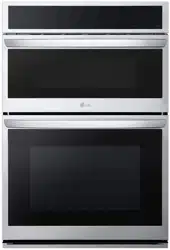Loading ...
Loading ...
Loading ...

23OPERATION
ENGLISH
so that microwaves can be absorbed by the
underside and center of the foods.
- Shaping: Place the thickest portions of foods
like meat, poultry or fish toward the outside of
the cookware to help them cook more evenly.
If possible, shape foods into thin rounds or
rings.
• Foods with Skin, Shell or Membrane
- Skin or Membrane: Pierce the outsides of
foods like potatoes, sausages, or egg whites or
yolks before cooking.
- Shell: Pierce or remove the shells from eggs,
clams, oysters, or other shelled foods before
cooking.
• Testing if Cooked
- Microwaves cook food quickly, so test food for
doneness frequently. Some foods are left in
the microwave until completely cooked, but
most foods, including meats and poultry,
should be removed from the oven while still
slightly undercooked and allowed to finish
cooking during standing time. The internal
temperature of foods will rise between 5 °F (3
°C) and 15 °F (8 °C) during standing time.
• Defrosting Tips
- Remove fish, shellfish, meat, and poultry from
their original wrapping paper or plastic
package. Otherwise, the wrap close to the food
will hold steam and heat, which can cause the
outer surface of the food to be cooked.
- Remove any metal twist ties.
- Always slit or pierce plastic pouches or
packaging.
- Open containers such as cartons before they
are placed in the oven.
- If food is foil wrapped, remove the foil and
place the food in a suitable container.
- The length of defrosting time varies
depending on the shape of the food and on
how solidly the food is frozen.
- As food begins to defrost, separate the food
into pieces so that they can defrost more
easily.
- Turn over food during defrosting or standing
time. Separate into pieces and remove food as
required.
- Let food stand after defrosting. Food should
still be somewhat icy in the center when
removed from the oven.
- When using Defrost, the weight to be entered
is the net weight in pounds and tenths of
pounds (the weight of the food minus the
container).
- Slit the skins of frozen food such as sausage.
- Bend plastic pouches of food to ensure even
defrosting.
- Place food in a shallow container or in a
microwave roasting dish to catch the
drippings.
- Always underestimate defrosting time. Food
should still be somewhat icy in the center
when removed from the oven. If defrosted
food is still frozen solid in the center, return it
to the upper oven for more defrosting.
- Depending on the shape of the food, some
areas may defrost more quickly than others.
- The shape of the package affects how quickly
food will defrost. Shallow packages will defrost
more quickly than a deep block.
- For best results, shape ground meat into the
form of a doughnut before freezing. When
defrosting, scrape off thawed meat when the
beep sounds and continue defrosting.
-
Use
small pieces of aluminum foil to shield
parts of food such as chicken wings, leg tips,
fish tails, or areas that start to get warm. Make
sure the foil does not touch the sides, top, or
bottom of the oven. The foil can damage the
oven lining.
Microwave Power Levels
This microwave oven is equipped with 10 power
levels to give you maximum flexibility and control
over cooking.
Power
Level
Use
10
(100%)
• Boiling water
• Browning ground beef
• Making candy
• Cooking whole poultry, poultry
pieces, fish & vegetables
• Cooking tender cuts of meat
9
(90%)
• Reheating rice, pasta & vegetables
8
(80%)
• Reheating prepared foods quickly
• Reheating sandwiches
7
(70%)
• Cooking egg, milk and cheese
dishes
• Cooking cakes and breads
• Melting chocolate
en-us_main.book.book Page 23 Tuesday, January 31, 2023 5:37 PM
Loading ...
Loading ...
Loading ...
